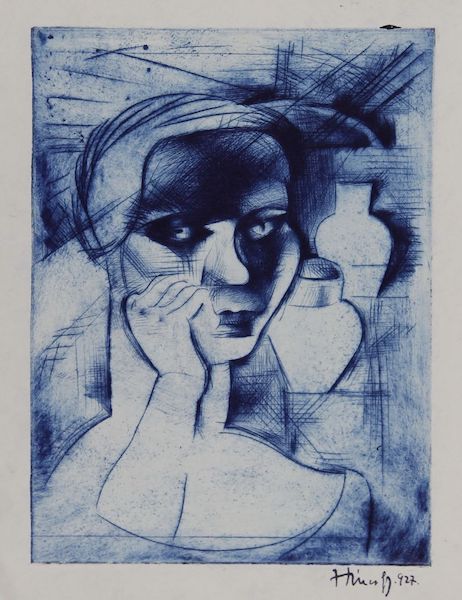Biography
Between 1922-1929 he attended the Hungarian Academy of Fine Arts, where his teachers were: Gyula Rudnay, János Vaszary. In 1928, during his study trip to Berlin, he came into contact with Herwarth Walden through the mediation of Hugó Scheiber, and in 1929, with the cooperation of Moholy-Nagy, he appeared in the Sturm Gallery. In 1928, he was a member of the Association of New Artists, and in 1929 of the New Society of Artists. Between 1930 and 1931, he received a scholarship from Rome. In 1943 he painted in Transylvania. Between 1947 and 1948, he was on a study trip to Korea, China, and Vietnam. Between 1946-1949, he was a teacher at the Hungarian College of Applied Arts. Between 1949-1963, he was a teacher at the Hungarian College of Fine Arts. 1952, 1957: Munkácsy Award; 1958: Kossuth Prize. Between 1958-1963, he was the director of the Hungarian Academy of Applied Arts. 1964: meritorious artist, 1968: outstanding artist. His flexible work was characterized by openness, vitality, and expressive power.
Thanks to his excellent technical knowledge and his ability to adapt and absorb everything, the most diverse masters and trends left their mark on his work. In his early drawings and etchings, the cubo-expressive formal language of the activists echoes, with manneristically elongated forms and dramatizing light-shadow contrasts. His etchings of 1925-1926, which make use of sensitive textural effects, are similar to Bernáth Aurél's etchings created between 1922-1924. In 1926, he was touched by surrealism in Paris, and he was one of the first to bring their magazines and manifestos home to Hungary. Far Eastern ink paintings, and especially Picasso, had a lifelong influence on his art. He also included classicizing motifs in the post-cubist order of his still lifes. These ink, pastel, and tempera pictures convey a special nostalgic dream world with their decorative, abstract style. Kaleidoscopically swirling, almost cosmic visions appear in his pictures, which, however, could not completely break out of the magic circle of the strong decorativeness inherent in the artist. Due to his French connection, his pictures fit well in the exhibitions of the New Society of Artists. He called his biomorphic, abstract compositions "amoebaism".
Between 1929 and 1932 he created abstract stage designs, and in 1933 a book pavilion. In the second half of the 1930s, he was one of the significant masters of the renewed expressive Hungarian art. He painted gloomy pictures of Lake Balaton in the early 1940s. The Transylvanian road in 1943 had a refreshing effect on his complexion. In many of his landscapes, his affection for this region through the Transylvanian, Saxon family tradition appeared with renewed, expressive colors. The II. After the Second World War, he continued his abstract compositions and also made collages. Stage designs, graphics, Anatole France illustrations indicate the wide range of his work. During his travels to Korea, China, and Vietnam in 1947-1948, he was touched by the calligraphic nature of the ancient Far Eastern line culture.
The artist's constant desire to experiment, his overly flexible habitus, not tied to any artistic trend, allowed him to fall into the sphere of attraction of the required social reality, e.g. on May 1. to paint a picture. Between 1950-1958 he worked on the Peace cycle. As a defense against aesthetic dogmas, folkloristic elements were mixed in his work when he immortalized the folk costumes of different landscapes. In addition to the obligatory themes and genre scenes, his pictures with an intimate atmosphere preserved their light picturesqueness. He deservedly won the silver medal at the Leipzig Book Art Exhibition in 1959 with his clean line-drawn book illustrations. His volume was published in Budapest in 1965 under the title Pen and Brush. In addition to his intimate graphics, he performed monumental, decorative tasks. The tapestries of the Fészek Klub were created following his designs between 1956 and 1959: the tapestry of the Friendship of Peoples and Martinász, and in 1967 the tapestry of the University of Agricultural Sciences in Debrecen. He designed a mosaic for Inota and sgraffito for the lobby of the Park Szálló. His large-scale oil paintings are monumental compositions with powerful colors, in which he compressed the turmoil of the age in a montage-like manner, the desire for peace into elementary symbols, and his faith in human knowledge and creation into Picasso motifs and figures. At other times, he drew on ancient Native American art to argue for the freedom of South American societies.
In 1970, in the sixteen-part glass mosaics of the V/2 building of the Budapest University of Technology, the theme of science and technology enabled him to express himself almost completely abstractly. His work is characterized by a swirling formal rhythm and a new interpretation of space. Then the large-scale mosaic of the Gödöllő University of Agricultural Sciences was born, and in 1973 the large glass window of SOTE. He kept his experimental spirit until the end of his life. He also experimented with small plastic and fired ceramics. A frequent model for his works was his wife, after whose death - from 1983 - he almost completely stopped creating.



